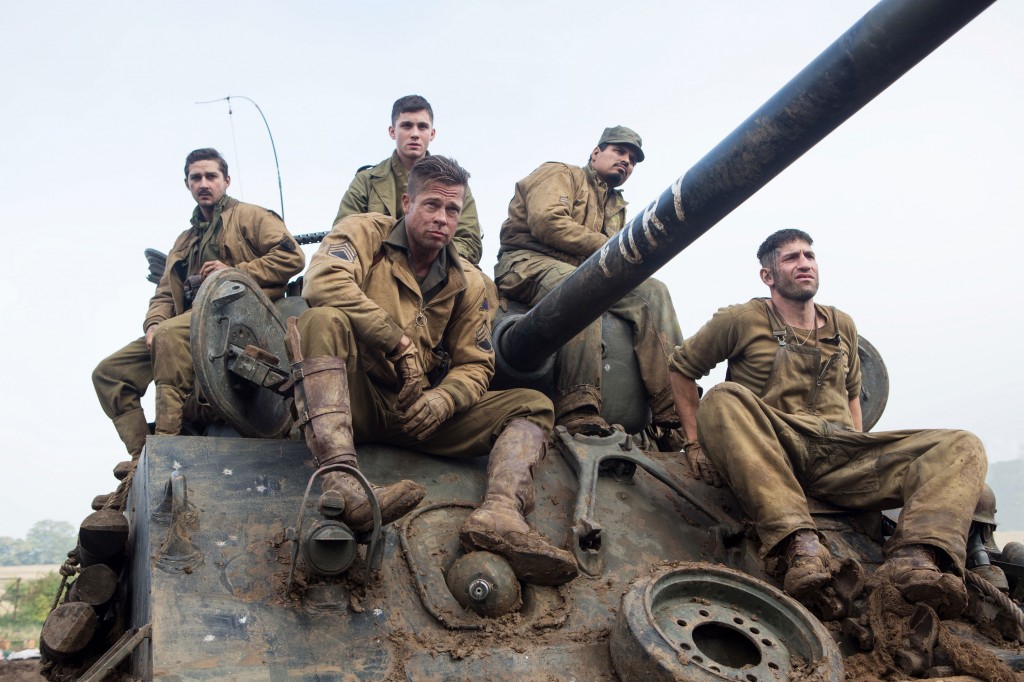
War is hell. And for 2 hours and 15 minutes, David Ayer’s new film, “Fury,” doesn’t muster anything beyond that tired, worn-out conceit. The film brutally portrays violence unapologetically and banally; limbs are blown apart, heads shot off and people set ablaze. But amidst the flesh and gore, Ayer wants to glorify and sentimentalize “The Greatest Generation” with a band of misfits teaming together like “The Dirty Dozen.” These conflicting objectives prevent “Fury” from ever finding its stride as a war film in an already over-saturated genre.
Brad Pitt stars as Sgt. Don “Wardaddy” Collier, a commander of a tank squadron nicknamed “Fury,” during the final months of the European theater. Other members of his merry band of Nazi killers are the scripture-quoting, Boyd “Bible” Swan (Shia LaBeouf), the southern white male stereotype, Grady “Coon-Ass” Travis (Jon Bernthal) and the Mexican American (unfortunately that’s all we know about him), Trini “Gordo” Garcia (Michael Peña). And of course, there is a new member to the crew: Norman Ellison, played by Logan Lerman, who has yet to earn a nickname.
Ellison’s role is simple. As the innocent, fresh-faced member of the crew, he is the surrogate to the audience, the one to mention how crazy and horrible everything is after it’s already become normal to those who have been in combat for years. Ellison watches in horror as others easily kills Nazis, some as young as ten years old. But soon, he finds himself one of them, filled with as much hatred for the enemy as he joins in the ritualistic chorus of saying, “Best job I ever had,” and means it.
For this tank squadron, brotherhood is the only way to get through this horrible war, showcasing a common David Ayer trope that dates back to his screenwriting debut in “Training Day.”
Ayer, as a director, is much like the film: filled with contradictions in style. At once, he masterfully fills his canvas with background details, like a woman in a wedding dress amongst the rubble. He doesn’t focus on her to create a heavy-handed metaphor. She is just a detail that populates his world. That same attention to detail is what makes some of the battle scenes thrilling. The centerpiece of the film is a 15-minute showdown between three American tanks against a far superior German Tiger Tank. Those 15 minutes are some of the most tense and suspenseful action seen in the theater this year.
But in other moments, Ayer displays baffling ineptitude in direction. “Fury” is bookended with an on-the-nose metaphor of a white horse running free in the shattered remains of the battlefield. The film is underscored by a schmaltzy choral score by Steven Price that cheapens dramatic tension. But the score is indicative of Ayer’s style: run by the id and the most superficial of emotions. The only way to prove his thesis is to show the most visceral violence imaginable while eliciting shallow tears and horrors.
The only moment that attempts to rise above Ayer’s id is a scene that feels atonal from the rest of the film. After the soldiers take a small German town, Wardaddy and Norman go to the home of two German women quivering in fear. As they interact with these women, there is a dramatic tension teetering between potential sexual violence and humane compassion. Soon, an impromptu family dynamic is created between these four characters as a feeble attempt to achieve normalcy during the height of brutality. Unfortunately, Ayer does not know how to punctuate that scene to give it the resonance that it deserves.
You can tell how hard the actors are working to give anything more than the one-dimensional characters they’re given. There’s some homoerotic tension between Bible and Wardaddy that probably wasn’t in the screenplay. LaBeouf has the best performance in the whole film even though he has little to do. Every actor rises above the material, no matter how ridiculous or sentimental the situation is with which Ayer presents them.
“Fury” presents itself as the next great realistic war film in the pantheon of the war films, but it never exhibits enough pathos or creativity to even sit in the same bunker. War is hell, but so is an artificial recreation of it.


